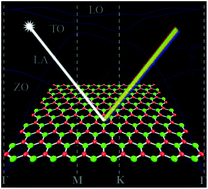Raman signature and phonon dispersion of atomically thin boron nitride†
Abstract
Raman spectroscopy has become an essential technique to characterize and investigate graphene and many other two-dimensional materials. However, there is still a lack of consensus on the Raman signature and phonon dispersion of atomically thin boron nitride (BN), which has many unique properties distinct from graphene. Such a knowledge gap greatly affects the understanding of the basic physical and chemical properties of atomically thin BN as well as the use of Raman spectroscopy to study these nanomaterials. Here, we use both experiment and simulation to reveal the intrinsic Raman signature of monolayer and few-layer BN. We find experimentally that atomically thin BN without interaction with a substrate has a G band frequency similar to that of bulk hexagonal BN (hBN), but strain induced by the substrate can cause a pronounced Raman shift. This is in excellent agreement with our first-principles density functional theory (DFT) calculations at two levels of theory, including van der Waals dispersion forces (opt-vdW) and a fraction of the exact exchange from Hartree–Fock (HF) theory through the hybrid HSE06 functional. Both calculations demonstrate that the intrinsic E2g mode of BN does not depend sensibly on the number of layers. Our simulations also suggest the importance of the exact exchange mixing parameter in calculating the vibrational modes in BN, as it determines the fraction of HF exchange included in the DFT calculations.

- This article is part of the themed collection: Editor’s Choice: Optical Spectroscopy of 2D materials


 Please wait while we load your content...
Please wait while we load your content...